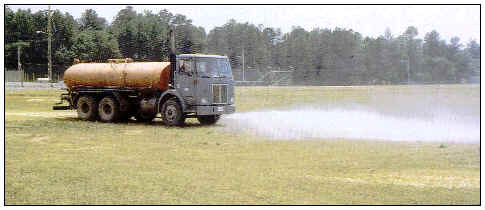Control of dust blowing and movement on construction sites and
roads.
PURPOSE
The purposes of this practice are to prevent blowing and
movement of dust from exposed soil surfaces, to reduce on and off-site damage,
to minimize health hazards, and to improve traffic safety.
CONDITIONS WHERE PRACTICE APPLIES
This practice is applicable to areas subject to dust blowing
and movement where on and off-site damage is likely without treatment.
CRITERIA
The following are temporary and permanent methods for dust
control.
Temporary Methods:
- Mulches - See practice standard MULCHING
875. Chemical or
wood cellulose fiber binders may be used instead of asphalt to bind mulch
material.
- Vegetative Cover - See practice standard TEMPORARY SEEDING
965.
- Spray-on Adhesives - These may be used on mineral soils.
They are not effective on muck soils. Keep traffic off these areas after
application.
- Anionic asphalt emulsion: water dilution - 7:1, coarse
spray, 1,200 gal/acre.
- Latex emulsion: water dilution - 12.5:1, fine spray, 235
gal/acre.
- Resin-in-water emulsion: water dilution - 4:1, fine spray,
300 gal/acre.
- Tillage - Roughen the surface and bring clods to the
surface. This is an emergency measure that should be used before soil
blowing starts. Begin tillage on windward side of site. Chisel plows with
shanks spaced about 12"-18" apart and spring-toothed harrows are
examples of equipment that may produce the desired effect.
- Irrigation - This is commonly used and affords fast
protection for haul roads and other heavy traffic roads. The site is
sprinkled with water until the surface is moist. Repeat as needed.
- Barriers - Solid board fences, snow fences, burlap fences,
crate walls, bales of hay and similar material can be used to control air
currents and blowing soil. Barriers placed at right angles to prevailing
wind currents at intervals of about 10 times their height are effective in
controlling soil blowing.
- Calcium Chloride - Apply at a rate that will keep the
surface moist. This chemical may be applied by a mechanical spreader as
loose, dry granules or flakes at a rate that keeps the surface moist but not
so much as to cause water pollution or plant damage. Application rates
should be strictly in accordance with the manufacturer's specified rates.
Periodic re-treatment may be needed.
- Stone - Stone can be used to stabilize roads or other areas
during construction using crushed stone or coarse gravel. See practice
standard STABILIZED CONSTRUCTION ENTRANCE 930.
- Street cleaning - Paved areas that have soil on them from
construction sites should be cleaned daily, or as needed, utilizing a street
sweeper or bucket-type end loader or scraper.
Permanent Method:
- Permanent vegetation - See the practice standard PERMANENT VEGETATION 880
or SODDING 925. Existing trees or large shrubs may afford valuable protection
if left in place.
CONSIDERATIONS
The easiest way to control dust is to avoid exposed soil
surfaces. This is not possible on most construction sites, but the area exposed
can usually be reduced by careful planning of controlled traffic patterns and by
phasing of clearing and grading operations. Consider use of undisturbed
vegetative buffers (min. 50 ft.) between graded areas and protected areas.
PLANS AND SPECIFICATIONS
Plans and specifications for dust control shall be in keeping
with this standard and shall describe the requirements for applying the practice
to achieve its intended purpose. At a minimum the following items should be
included:
- The area to be treated.
- The methods that are acceptable to use.
Specifications should indicate when dust control is needed and
the method of control to be used. Appropriate industry standards should be used.
All plans shall include the installation, inspection, and
maintenance schedules with the responsible party identified.
OPERATION AND MAINTENANCE
When temporary dust control measures are used, repetitive
treatment should be applied as needed to accomplish control.
NRCS IL
February 1994


